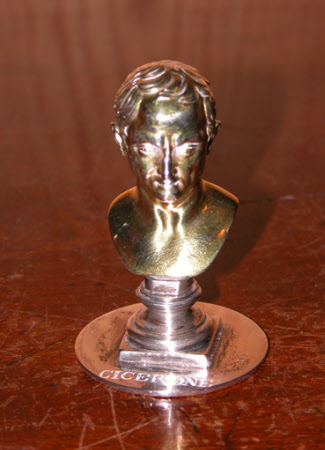Marcus Tullius Cicero (106-43 BC)
Italian School
Category
Art / Sculpture
Date
c. 1750 - 1800
Materials
Silver-gilt
Measurements
515 x 325 mm; 48 mm (Diameter)
Place of origin
Italy
Order this imageCollection
Anglesey Abbey, Cambridgeshire
NT 517628
Summary
Silver-gilt, Marcus Tullius Cicero (106-43 B.C.), Italian School, c. 1750-1800. A silver-gilt bust of the Roman orator Marcus Tullius Cicero, head and shoulders, looking slightly to his right. Mounted on a separately cast silver waisted socle on a broad circular base plate, inscribed CICERONE. A pair to a similar bust of Demosthenes (NT 517629).
Full description
Cicero (106-43 B.C.) was celebrated as an orator, active in public life in late Republican Rome and famous for the speeches he made in the forum of the city. In 63 B.C. Cicero was elected a consul, distinguishing himself in his role in the suppression of the Catiline conspiracy. After some years out of Rome, he returned in 49, just as the civil war between Julius Caesar and Pompey was breaking out. Cicero wrote most of his oratorical and rhetorical works during the following but, after the assassination of Caesar, Cicero was named as an enemy by new triumvirate of Octavian, Antony and Lepidus and, attempting to flee Rome, was murdered by their soldiers on 7 December 43. Rediscovered as an author by Petrarch in the fourteenth century, Cicero came in subsequent centuries to be regarded as one of the greatest Latin writers and guides to life. He was especially highly thought of in the eighteenth century and, as a great republican, he inspired the founding fathers of the United States of America and the revolutionary movement in France. Demosthenes and Cicero were therefore often portrayed together. They can for example be seen, along with the modern writers Francis Bacon and Sir Philip Sidney, on the engraved title page to The Academy of Eloquence by Thomas Blount, published in 1654 (example in National Portrait Gallery, NPG D25389). By the eighteenth century, Demosthenes and Cicero, had come to be regarded as the greatest orators of the ancient Greek and Roman worlds respectively, so pairs of portraits of the two men became even commoner. These tiny bust portraits were probably made in Italy, principally no doubt with the tourist market in mind. An identical version in bronze was formerly with the Surrey-based antiques dealers Brazil Antiques & Silver, who dated it to c. 1860. Jeremy Warren 2020
Provenance
Bequeathed to the National Trust by Huttleston Rogers Broughton, 1st Lord Fairhaven (1896-1966) with the house and the rest of the contents.
Credit line
Anglesey Abbey, The Fairhaven Collection (National Trust)
Marks and inscriptions
On base plate: CICERONE
Makers and roles
Italian School, sculptor
